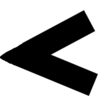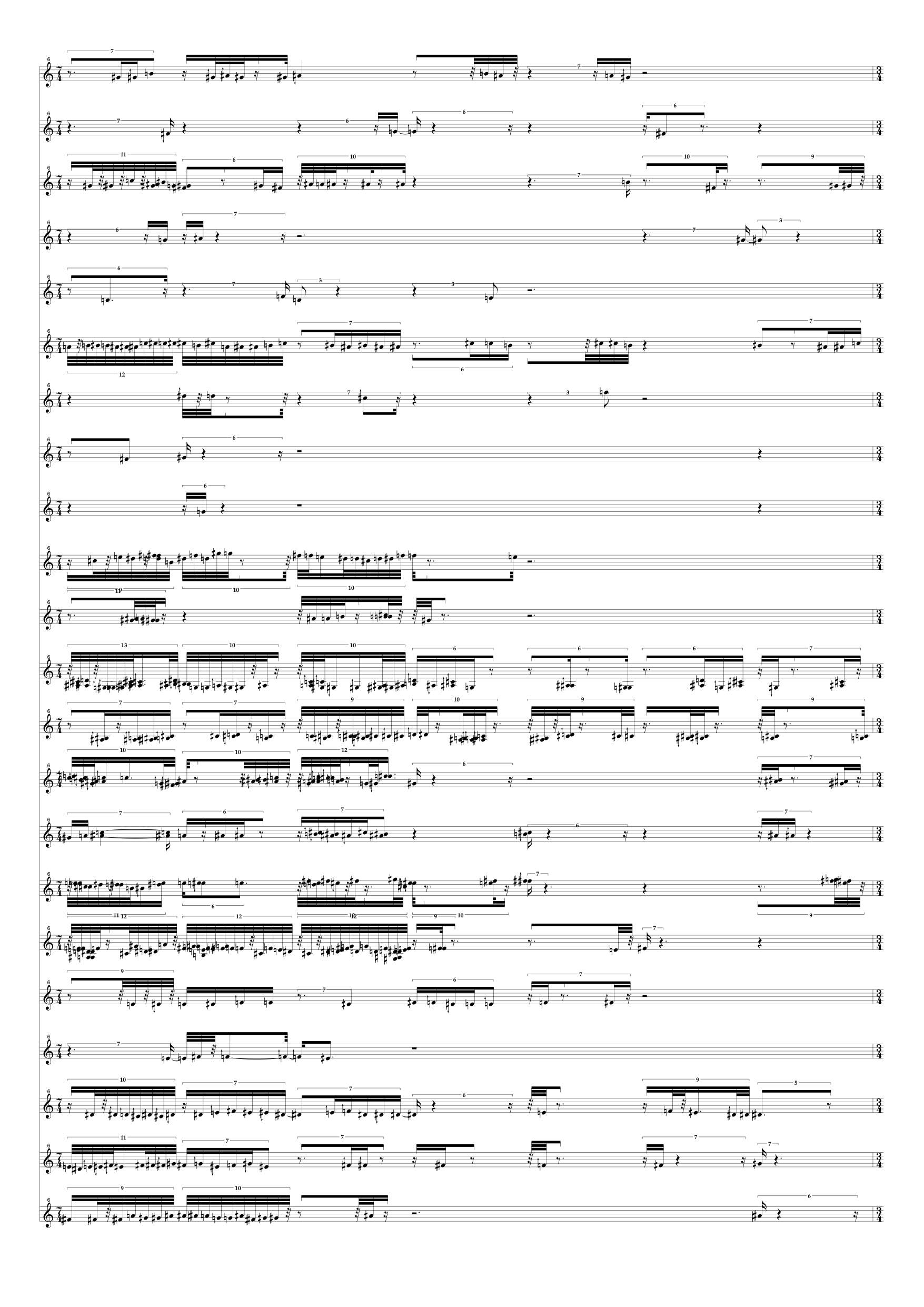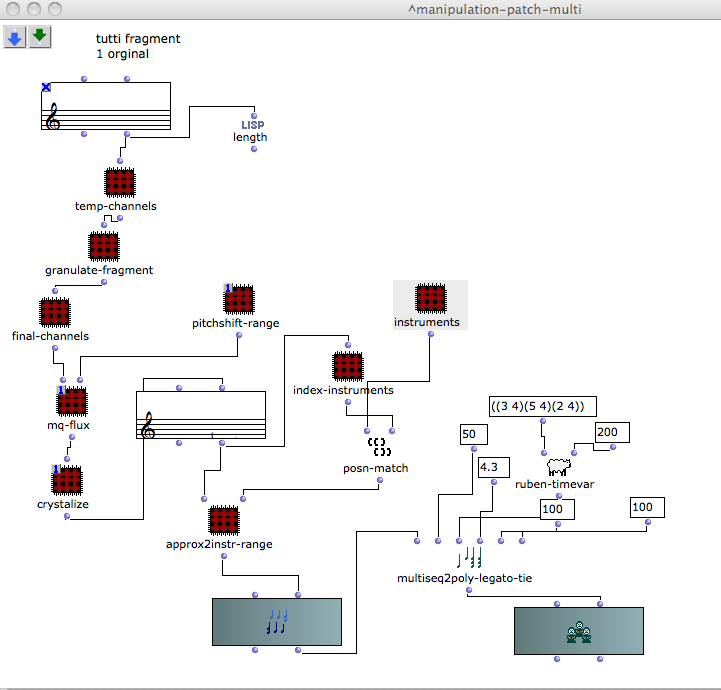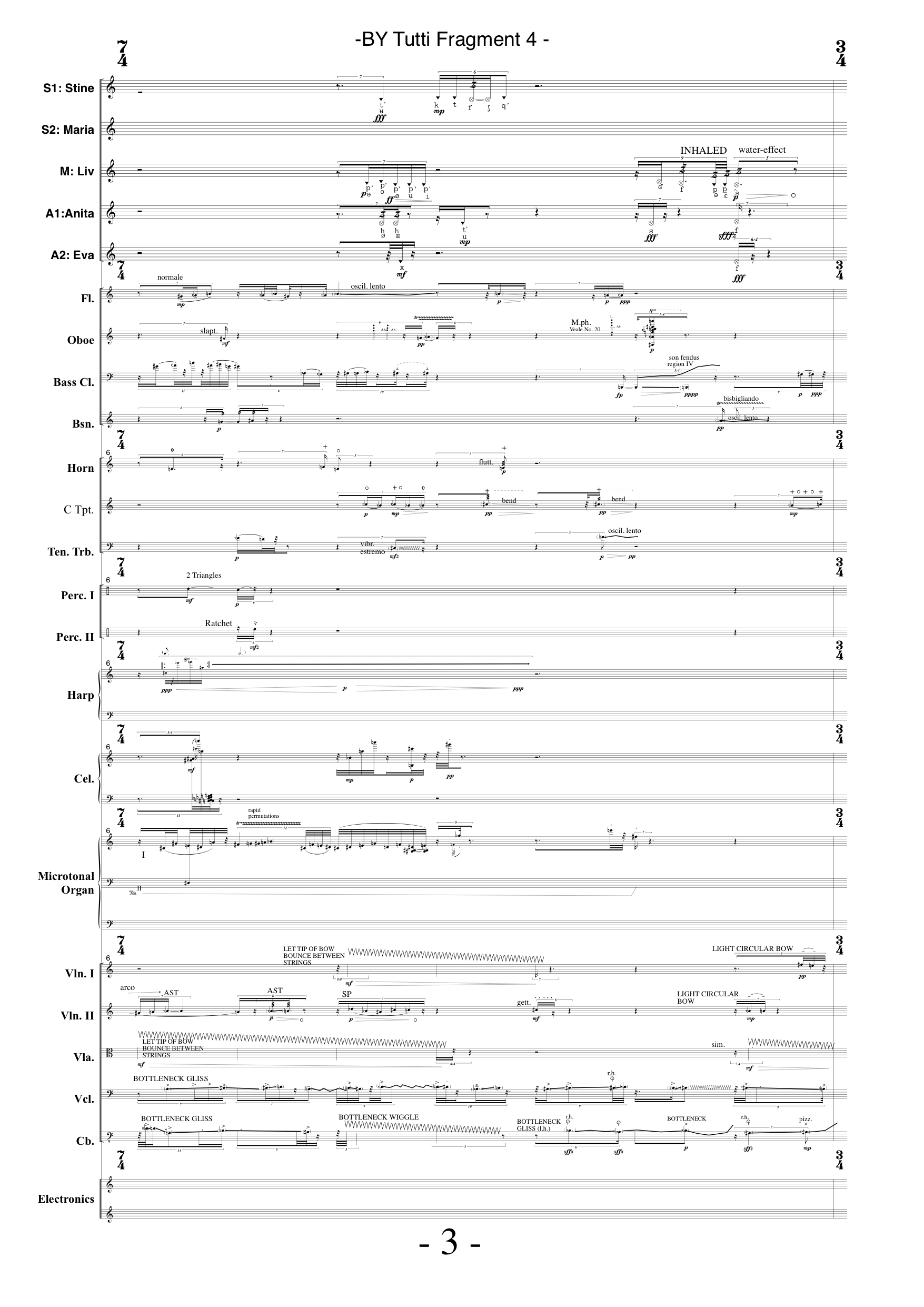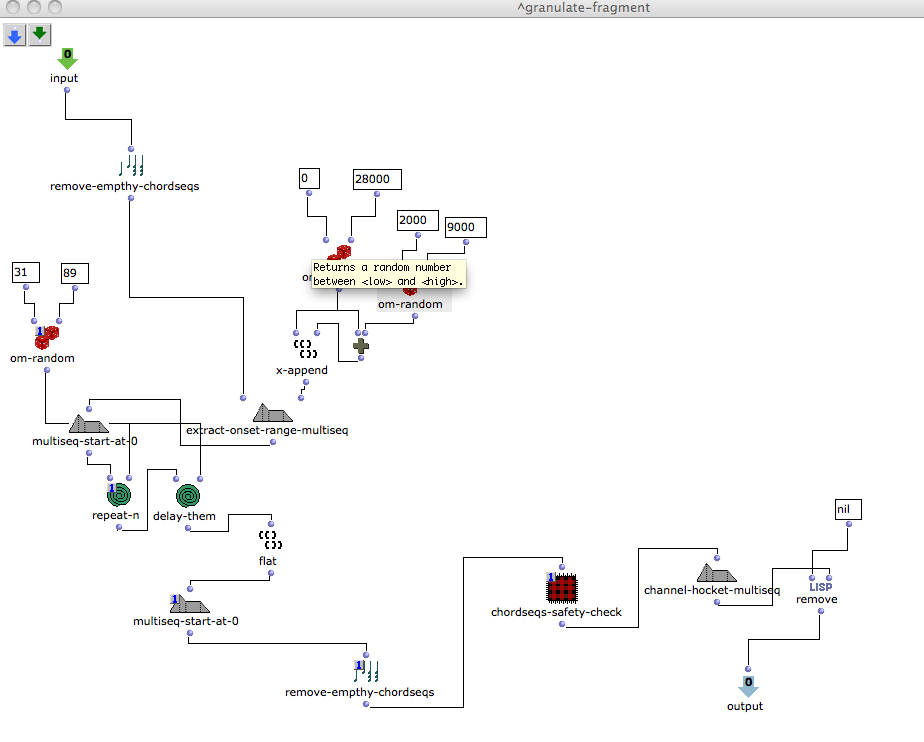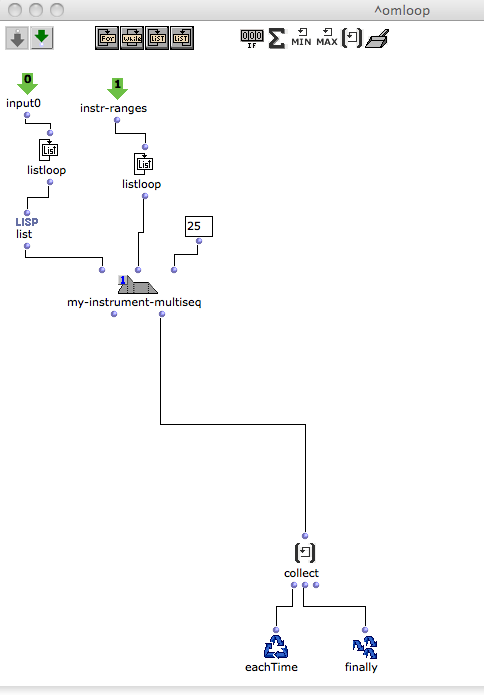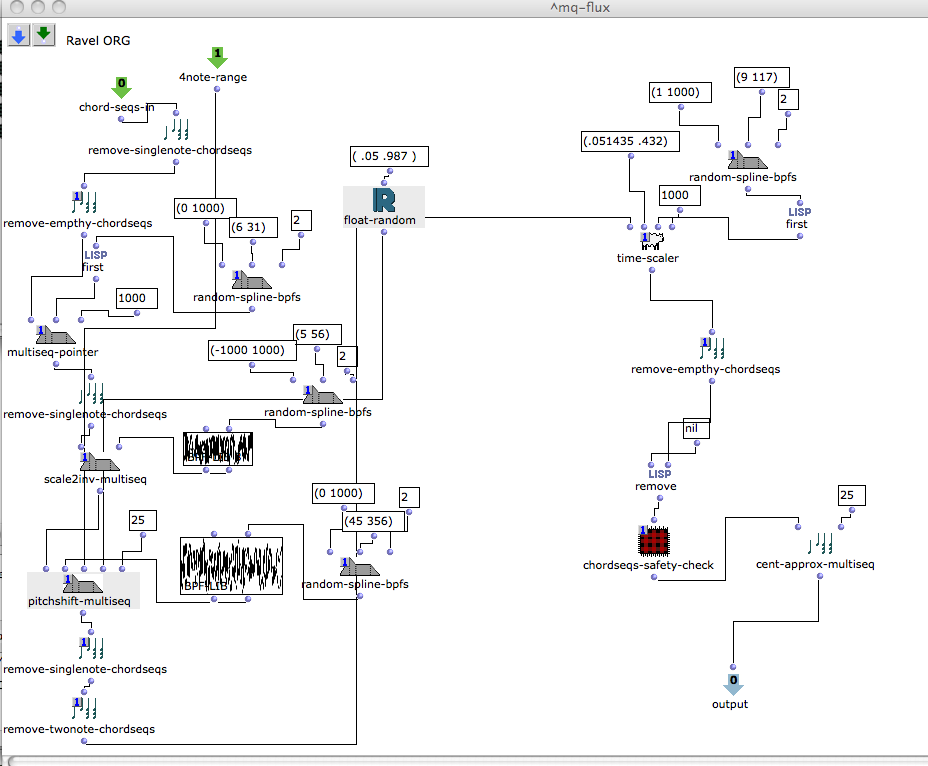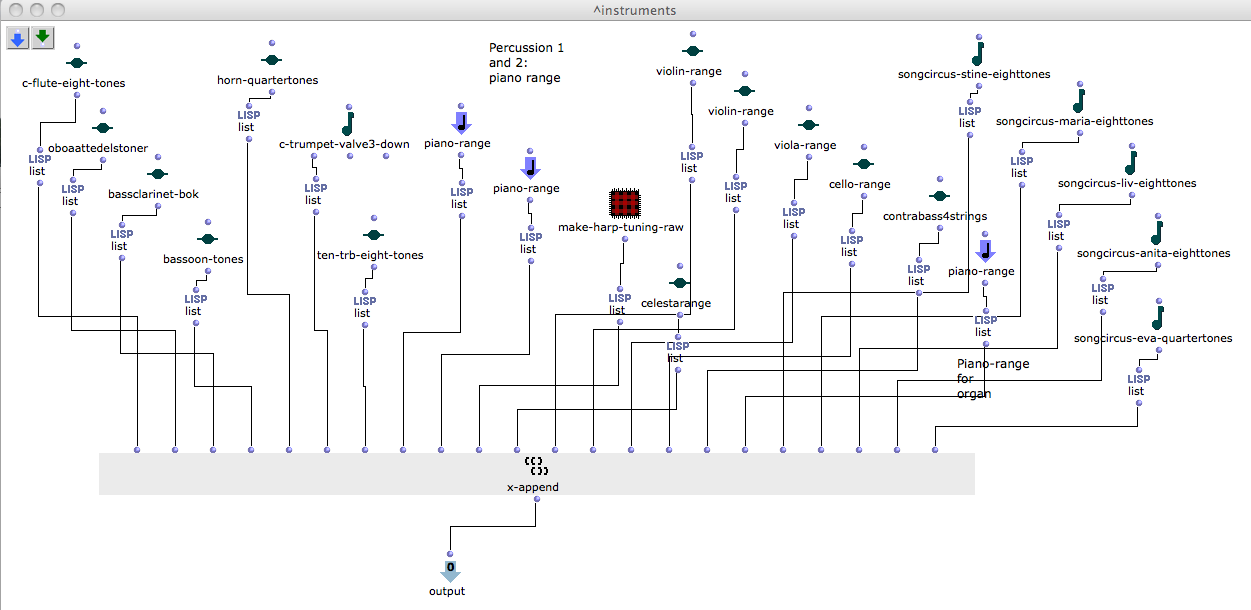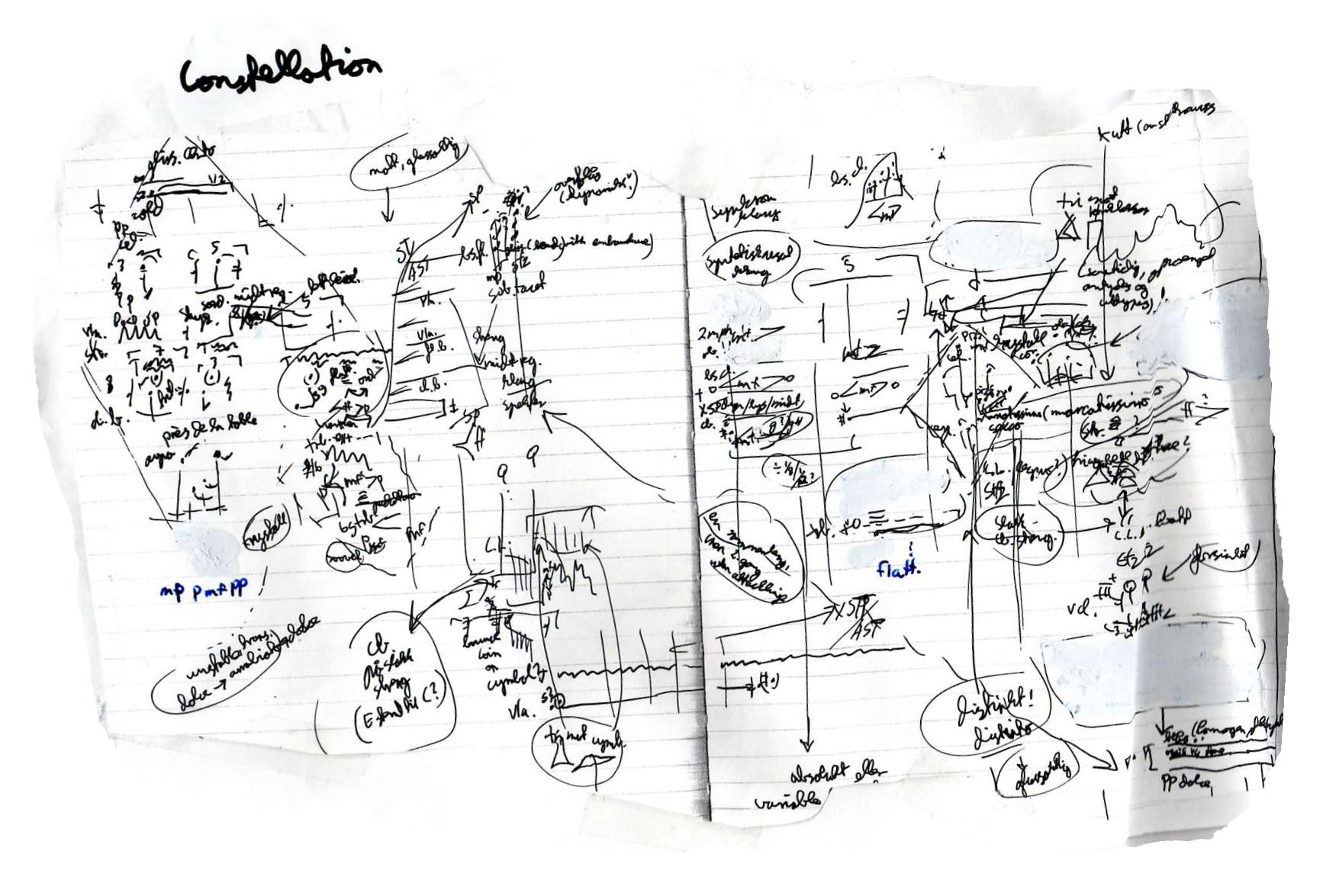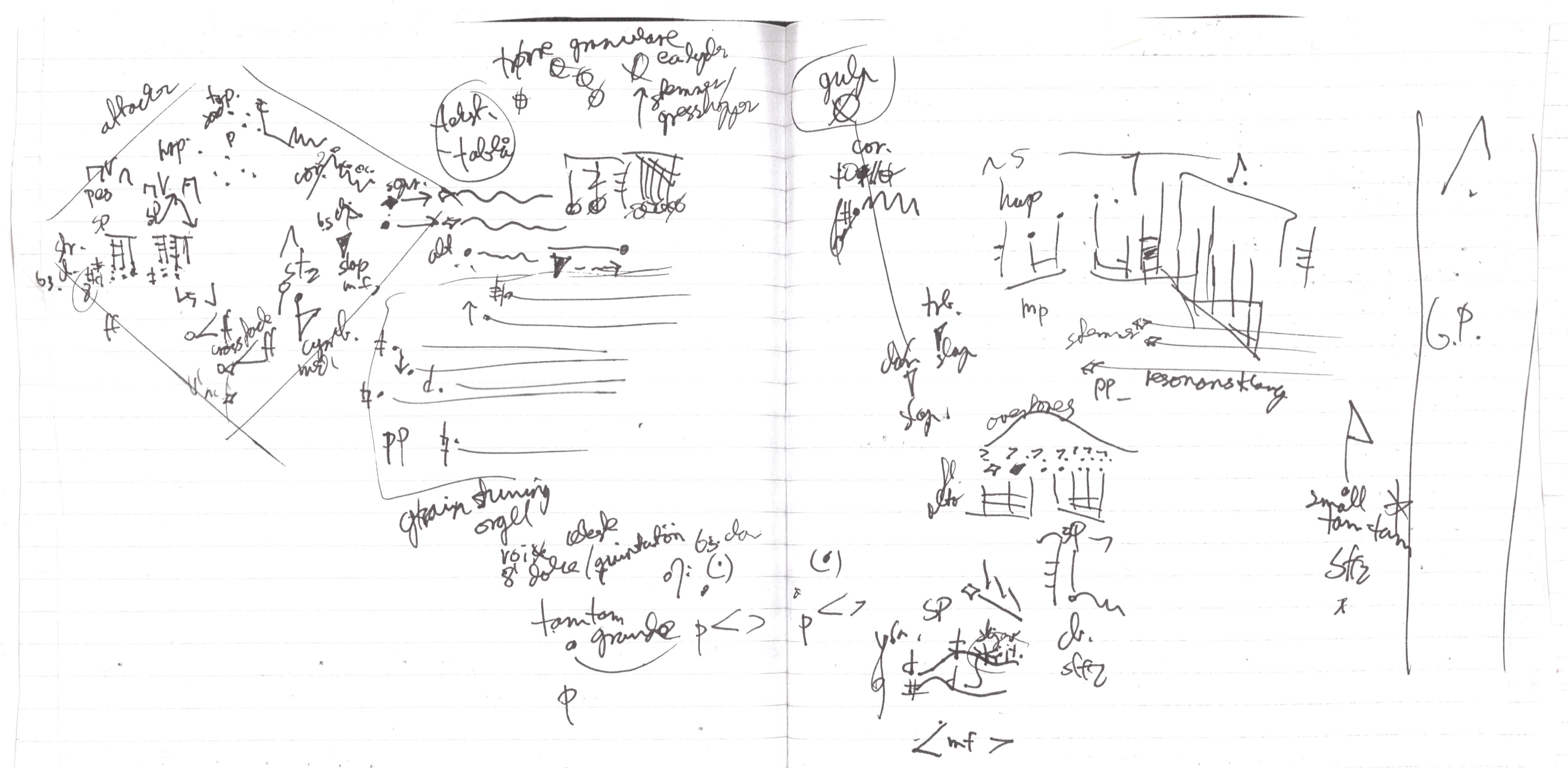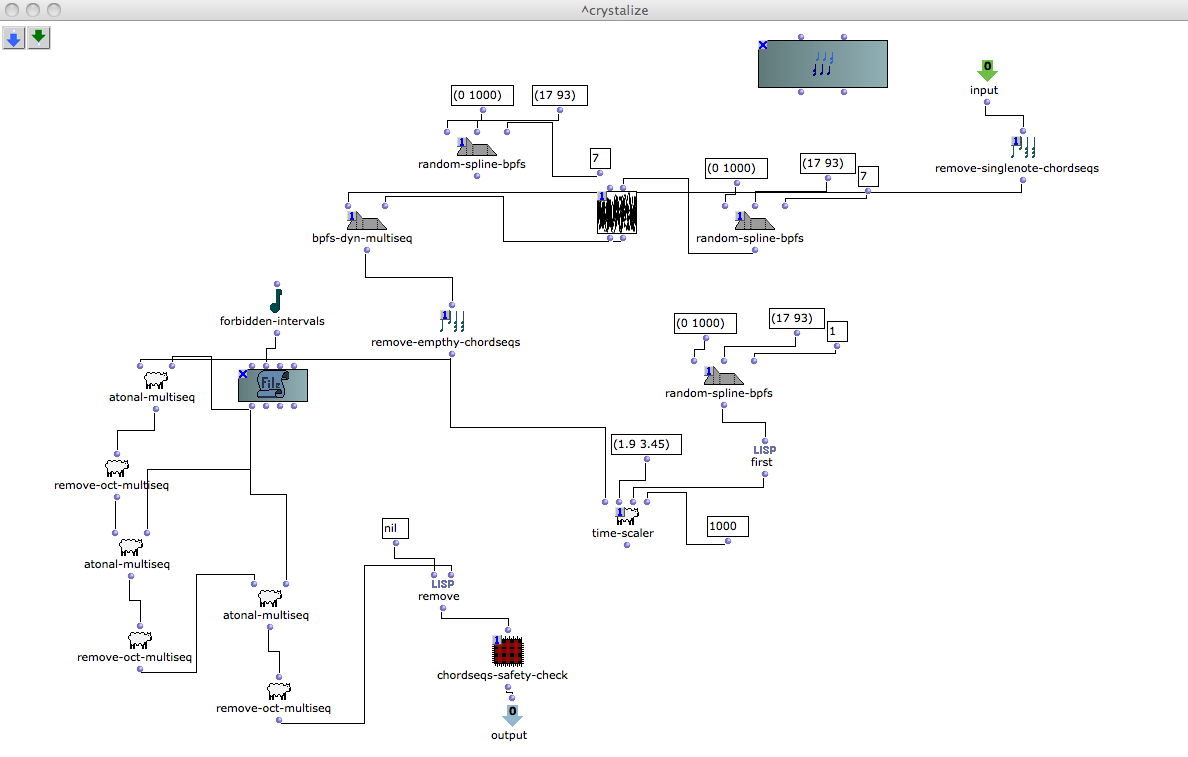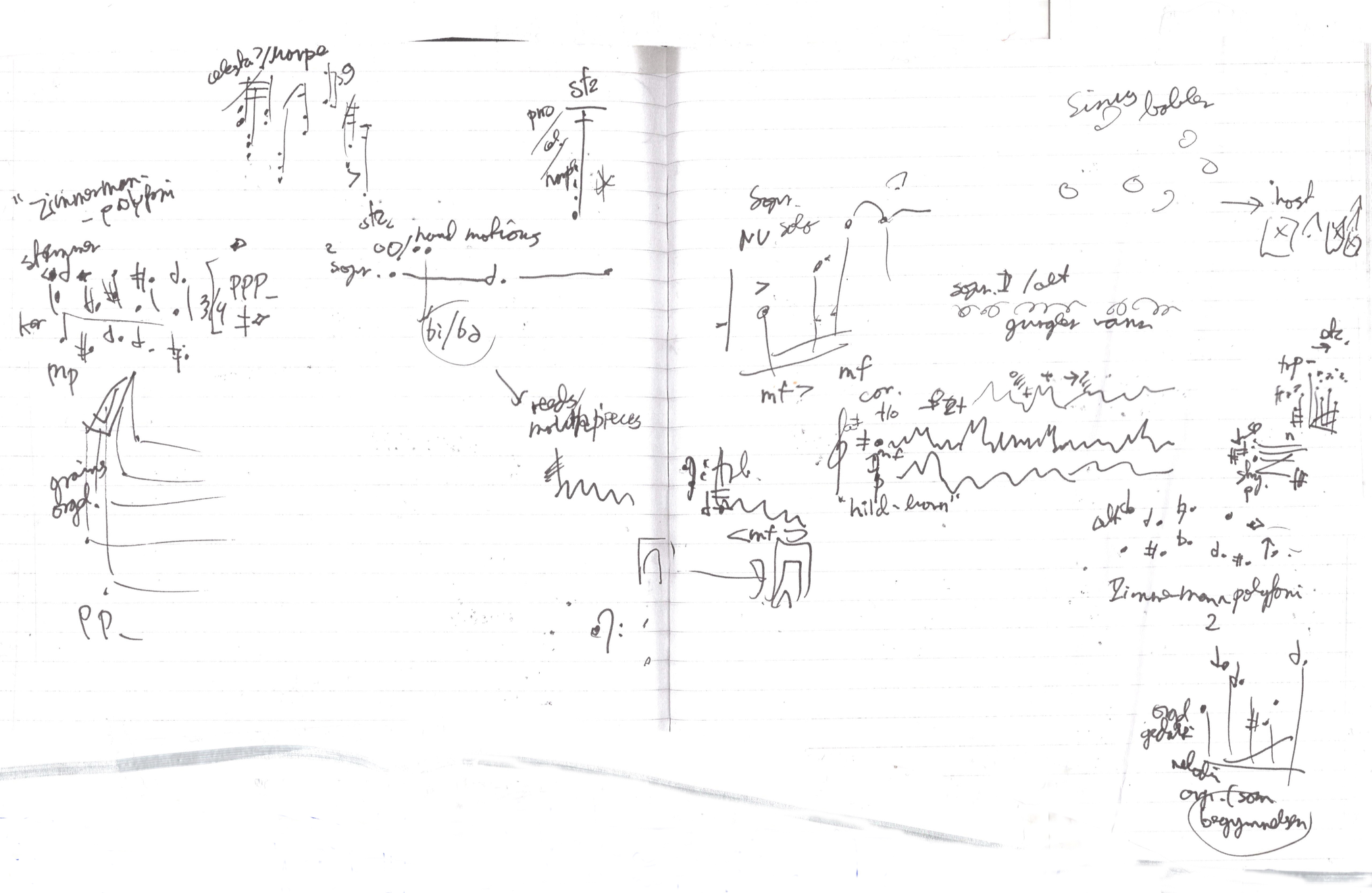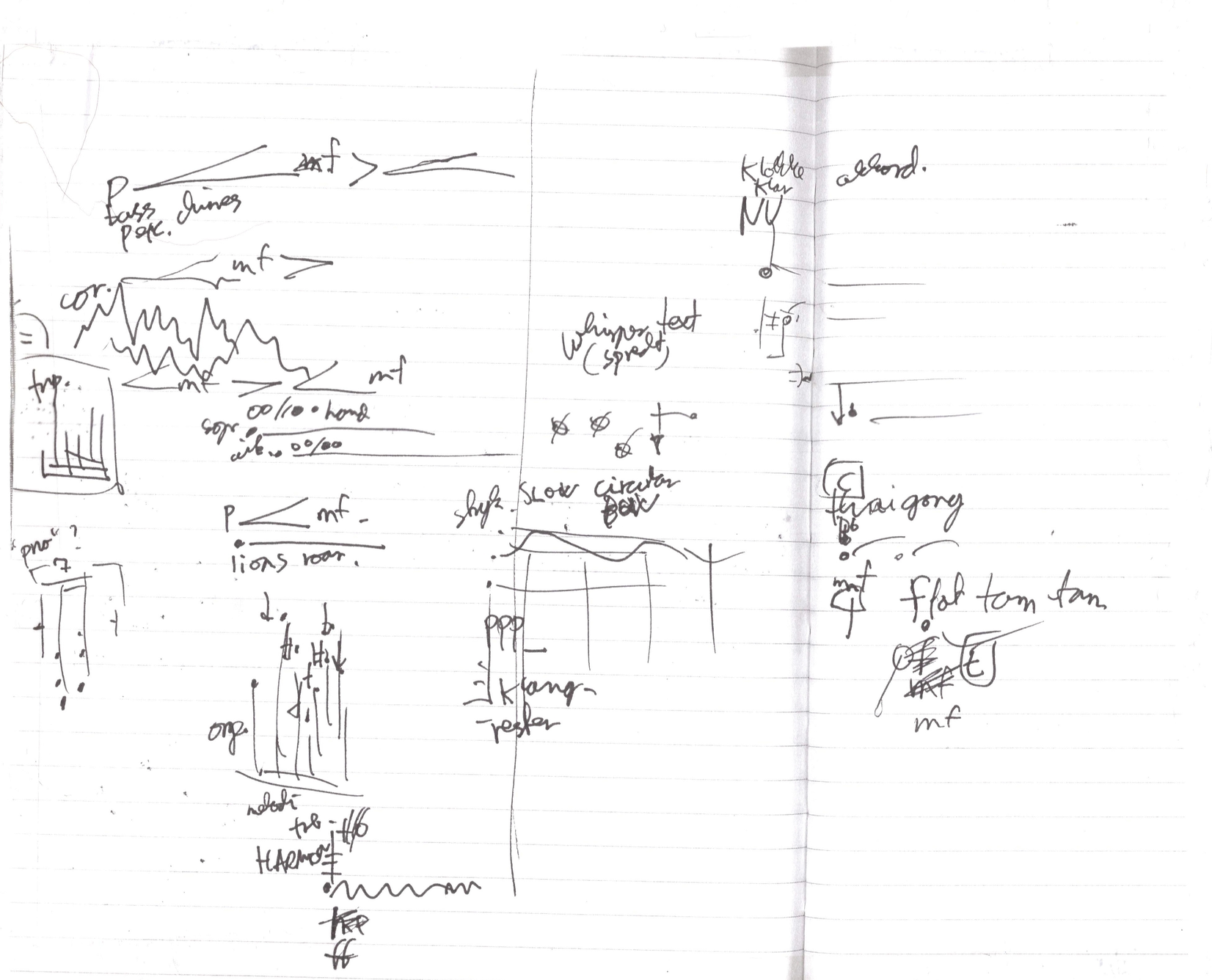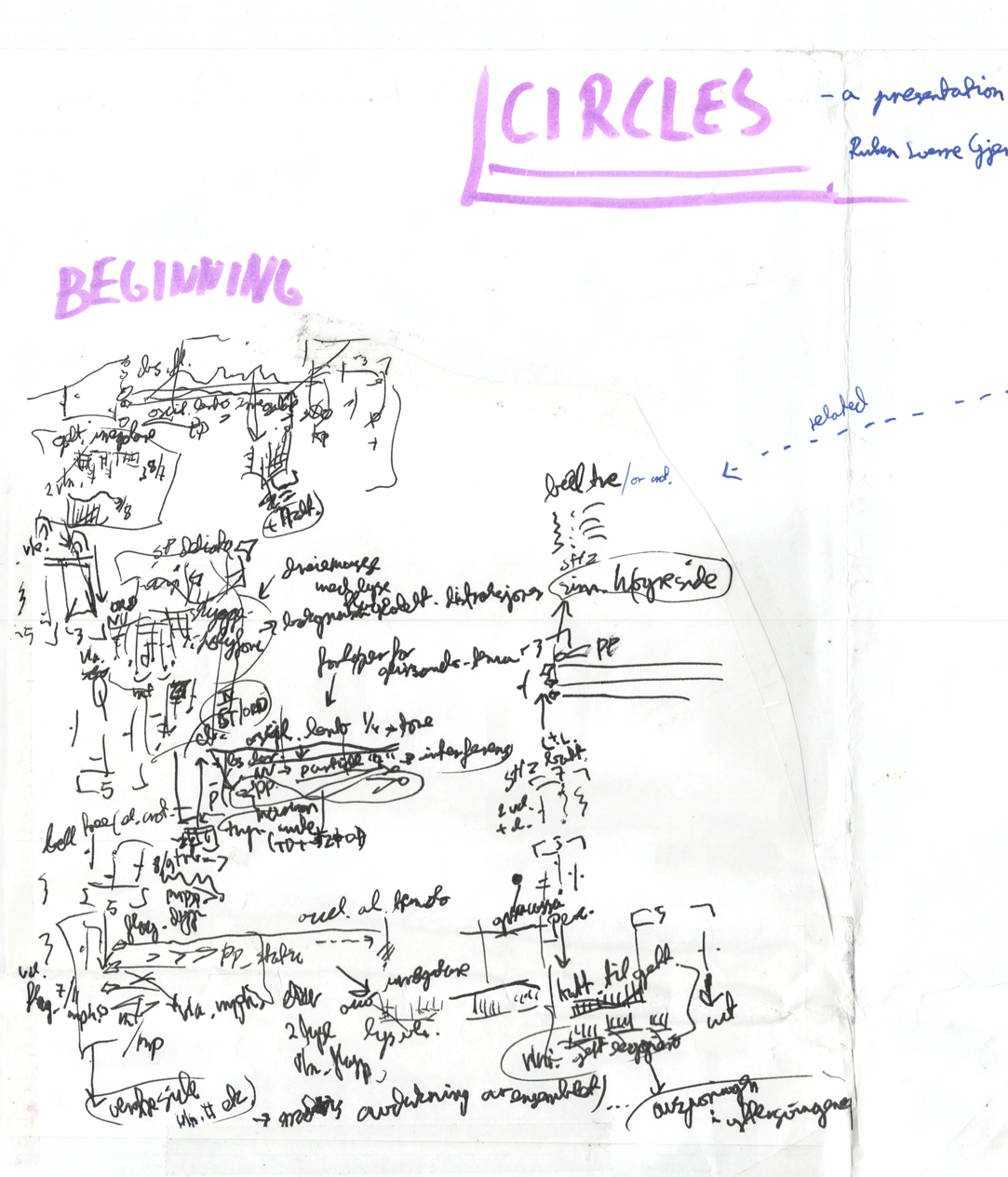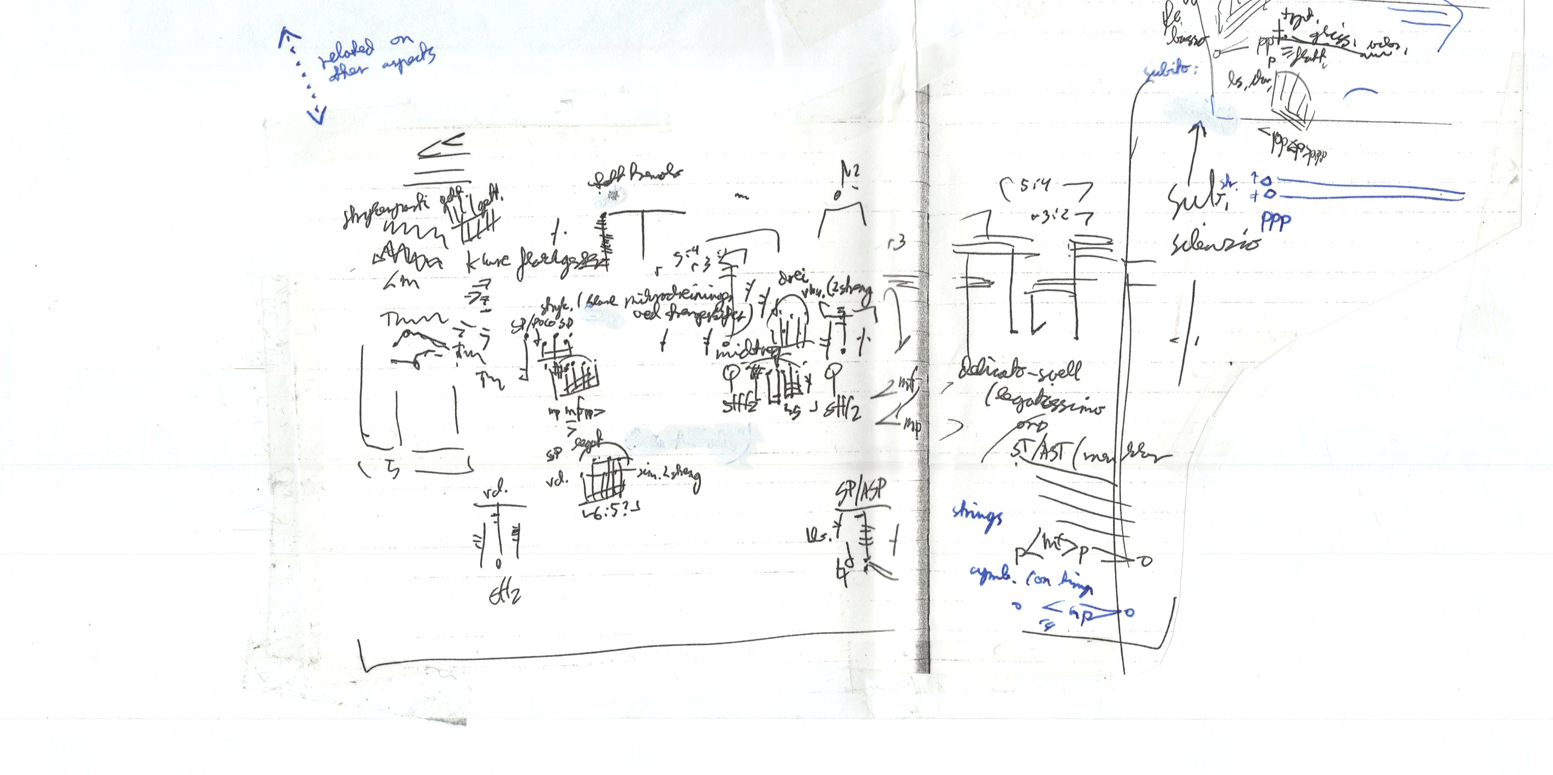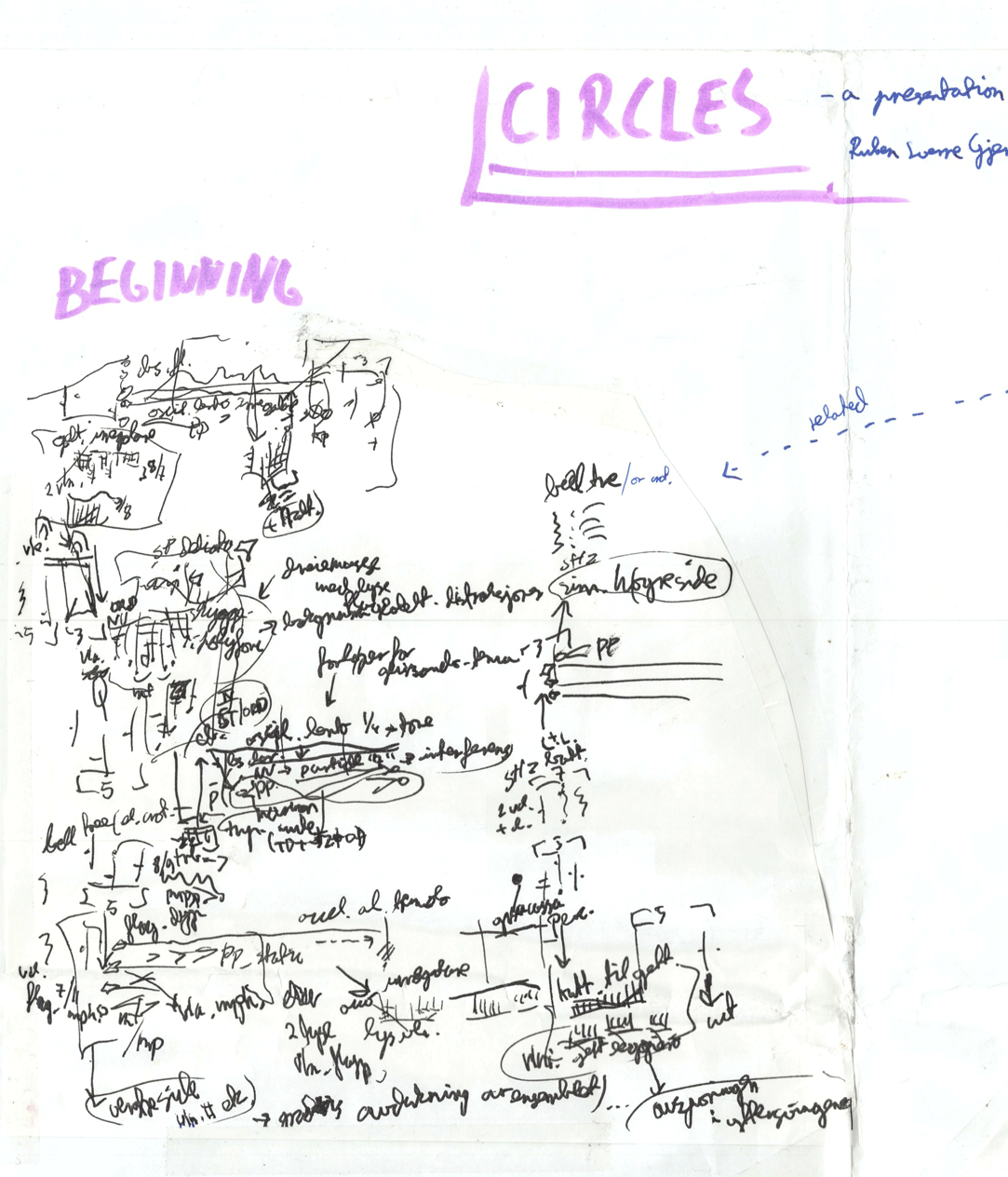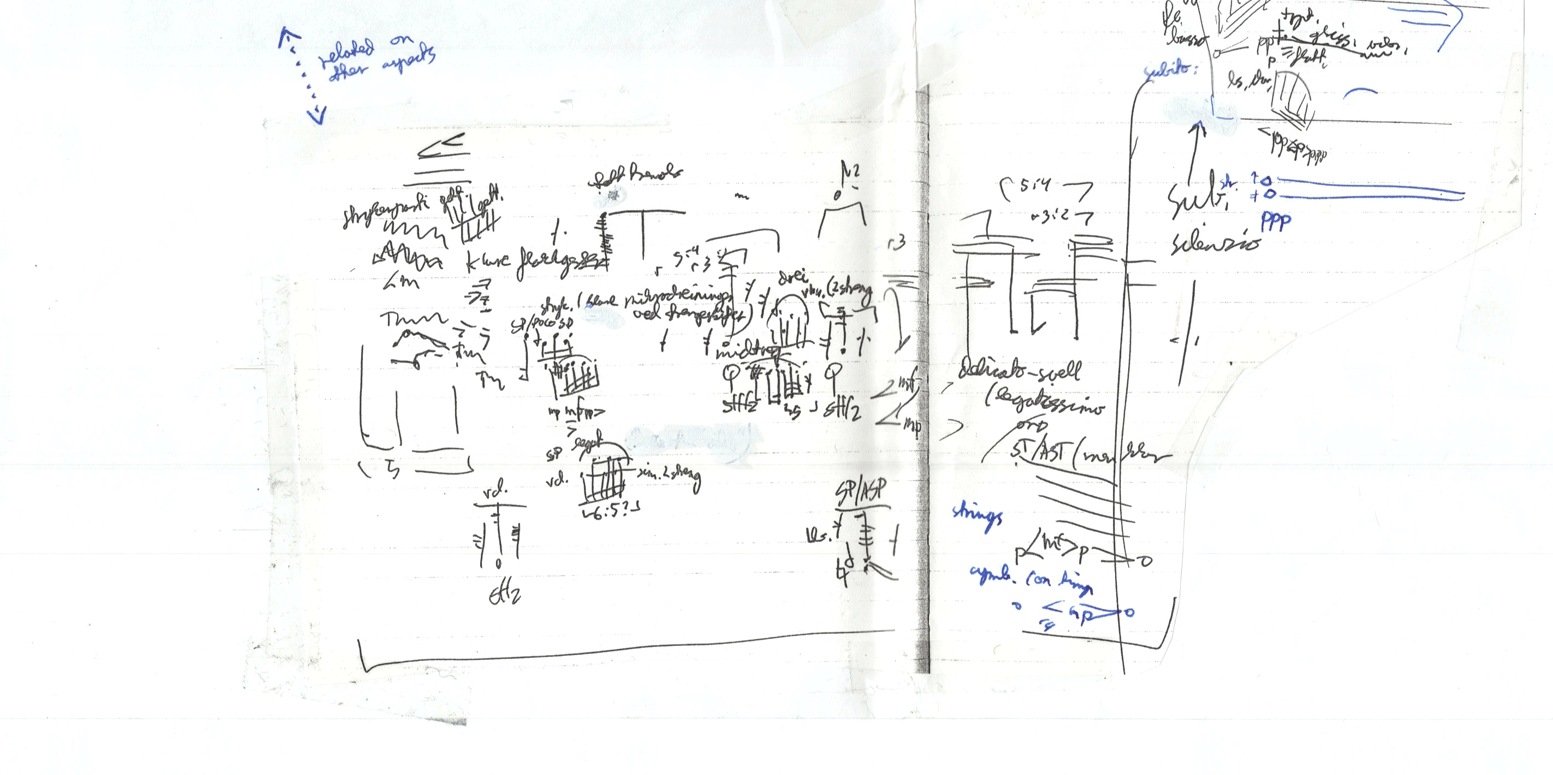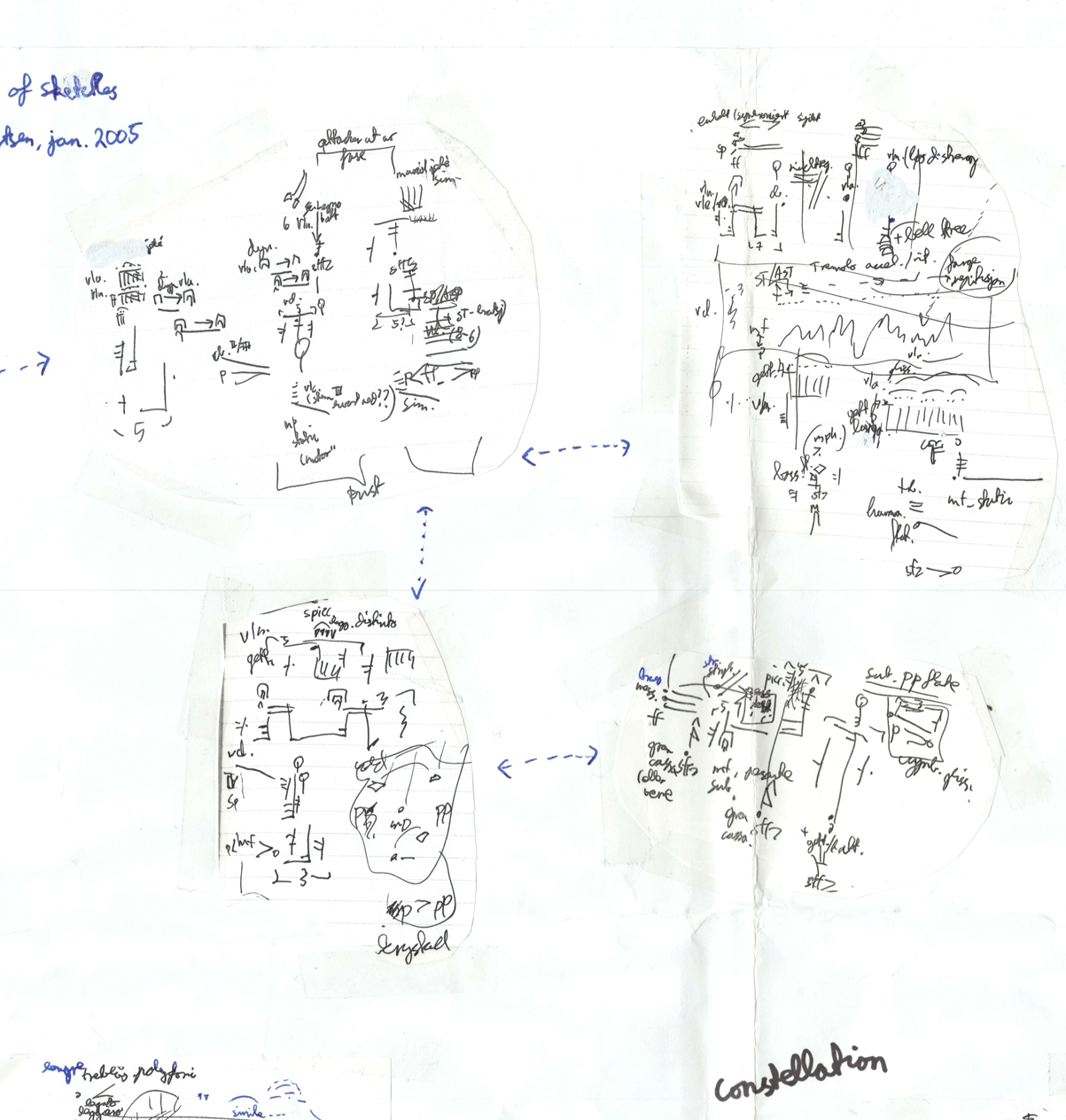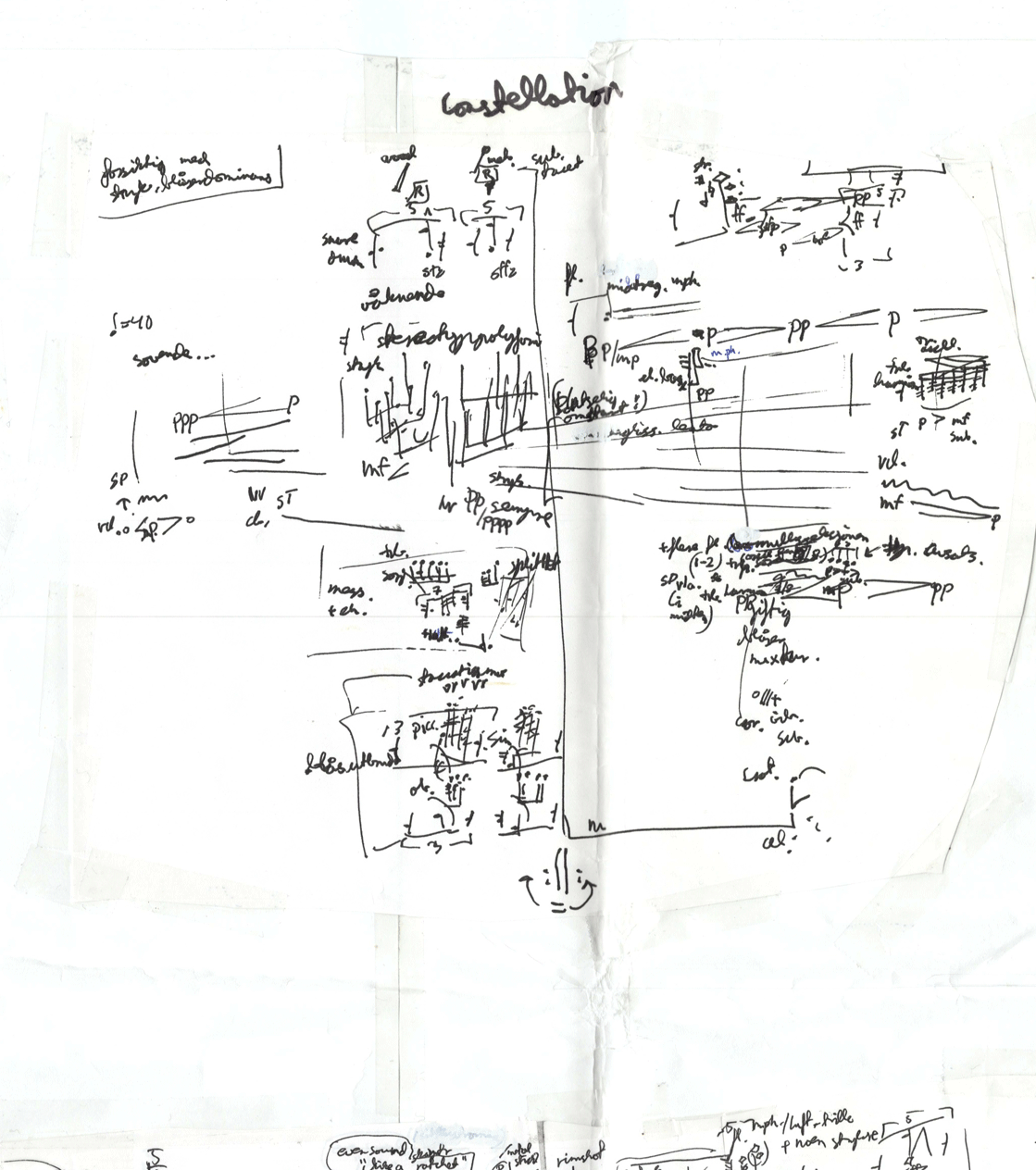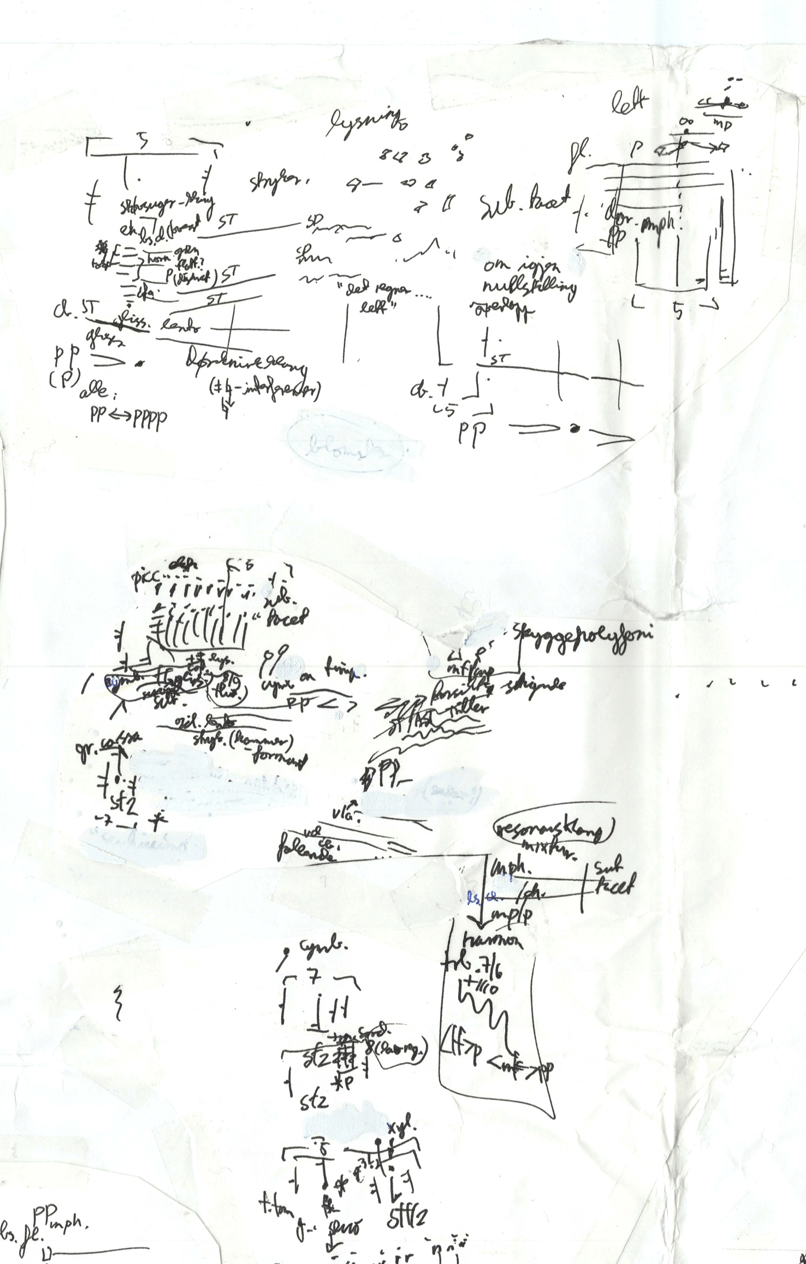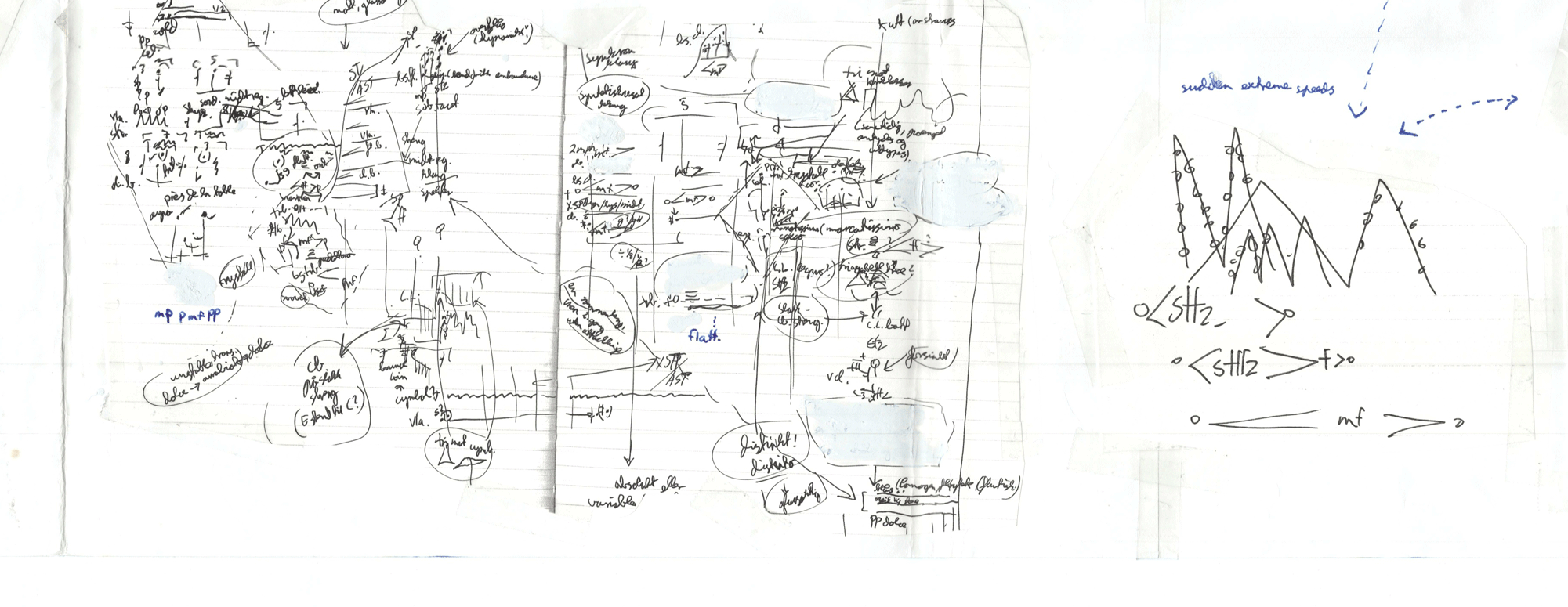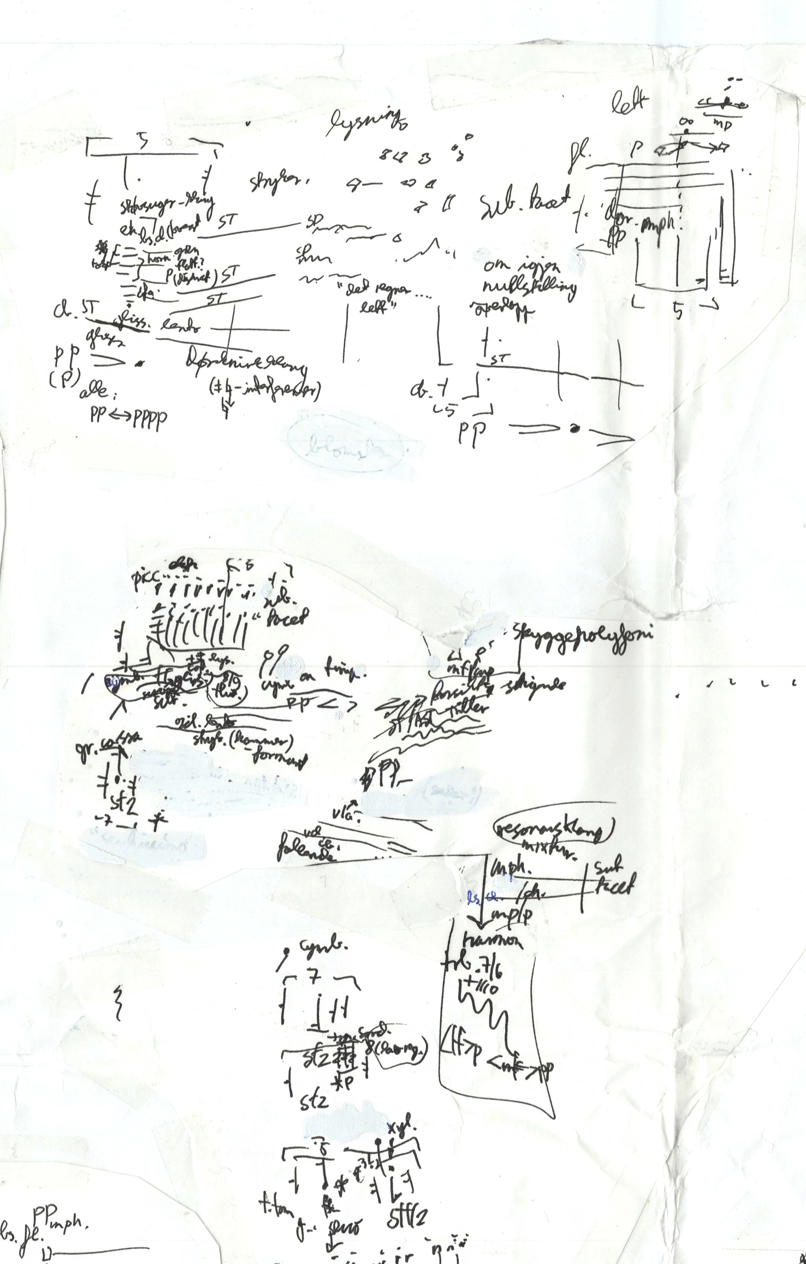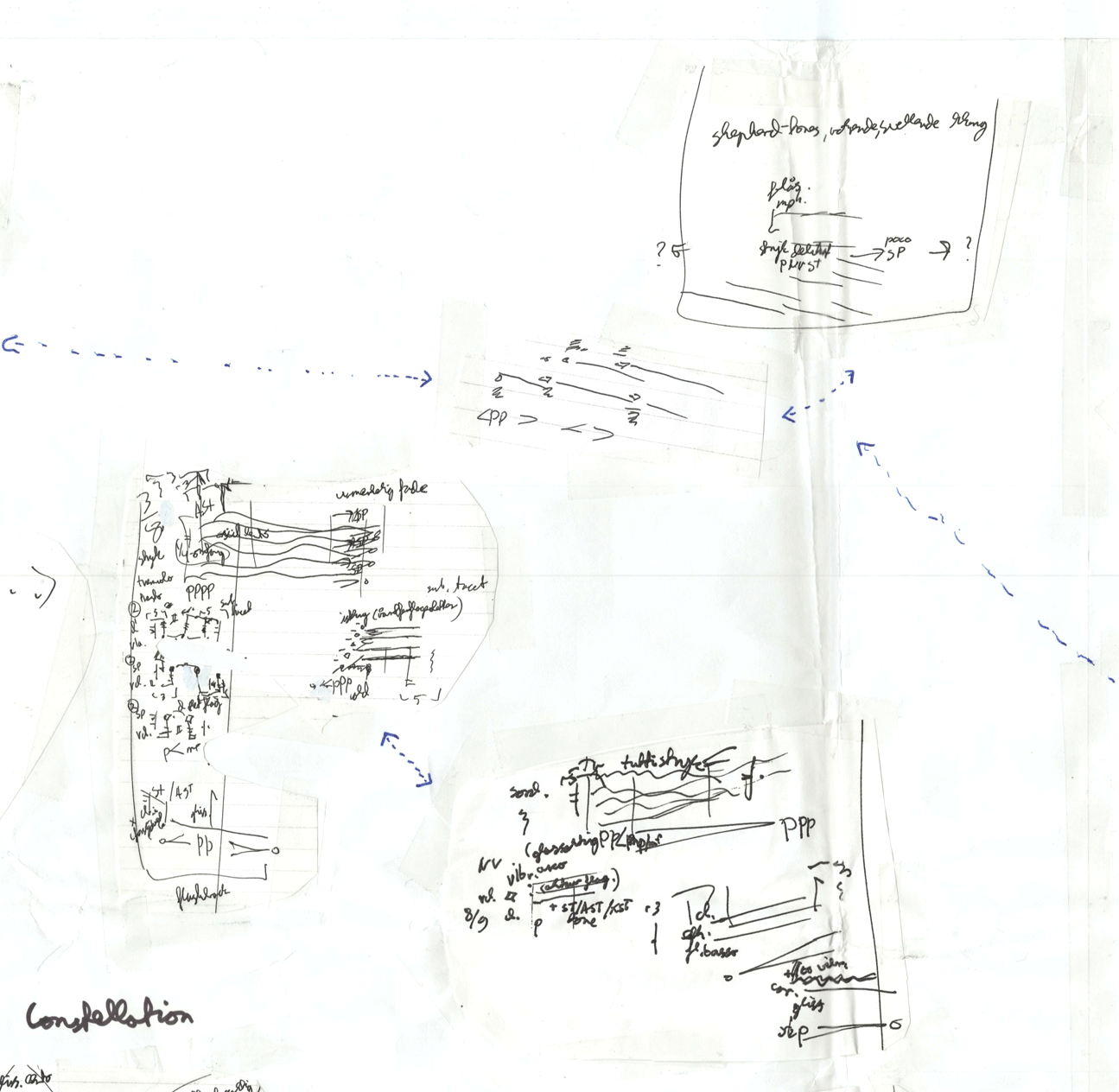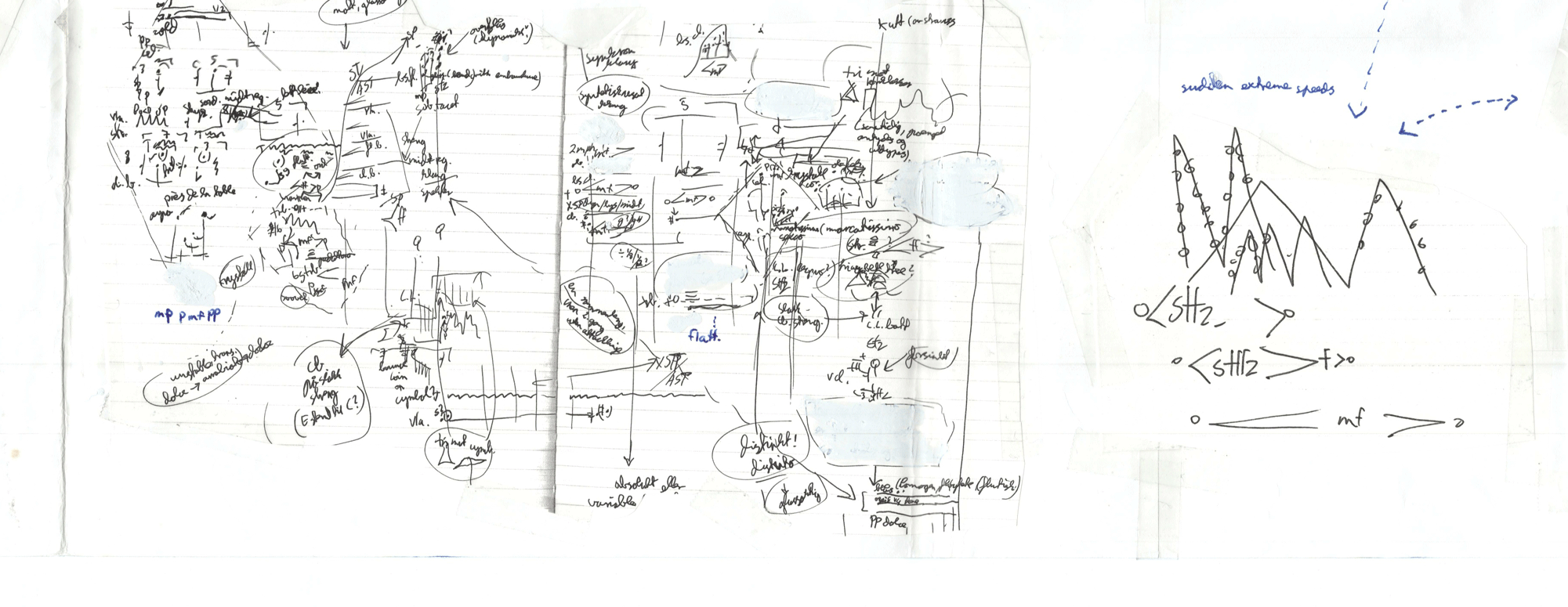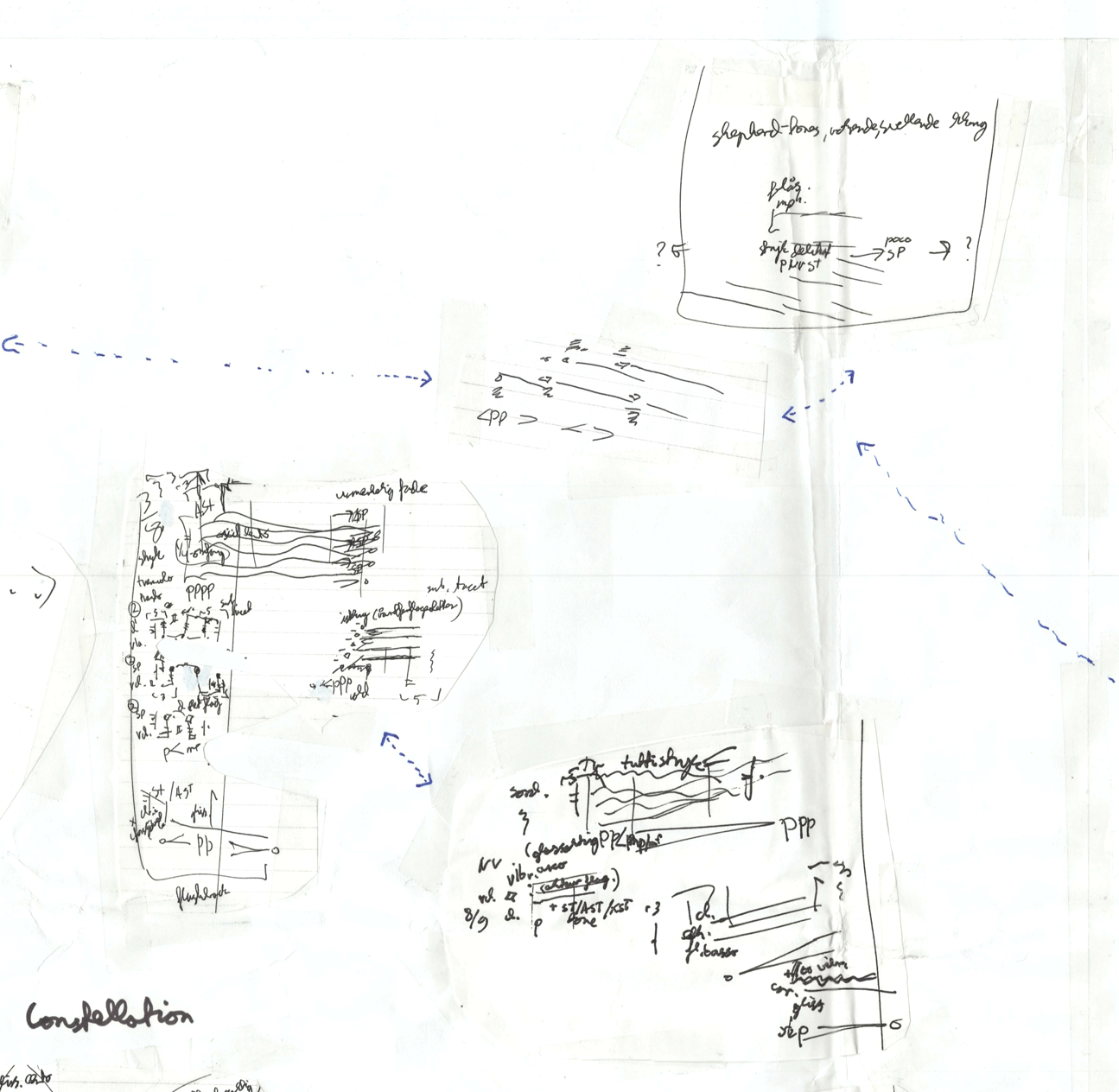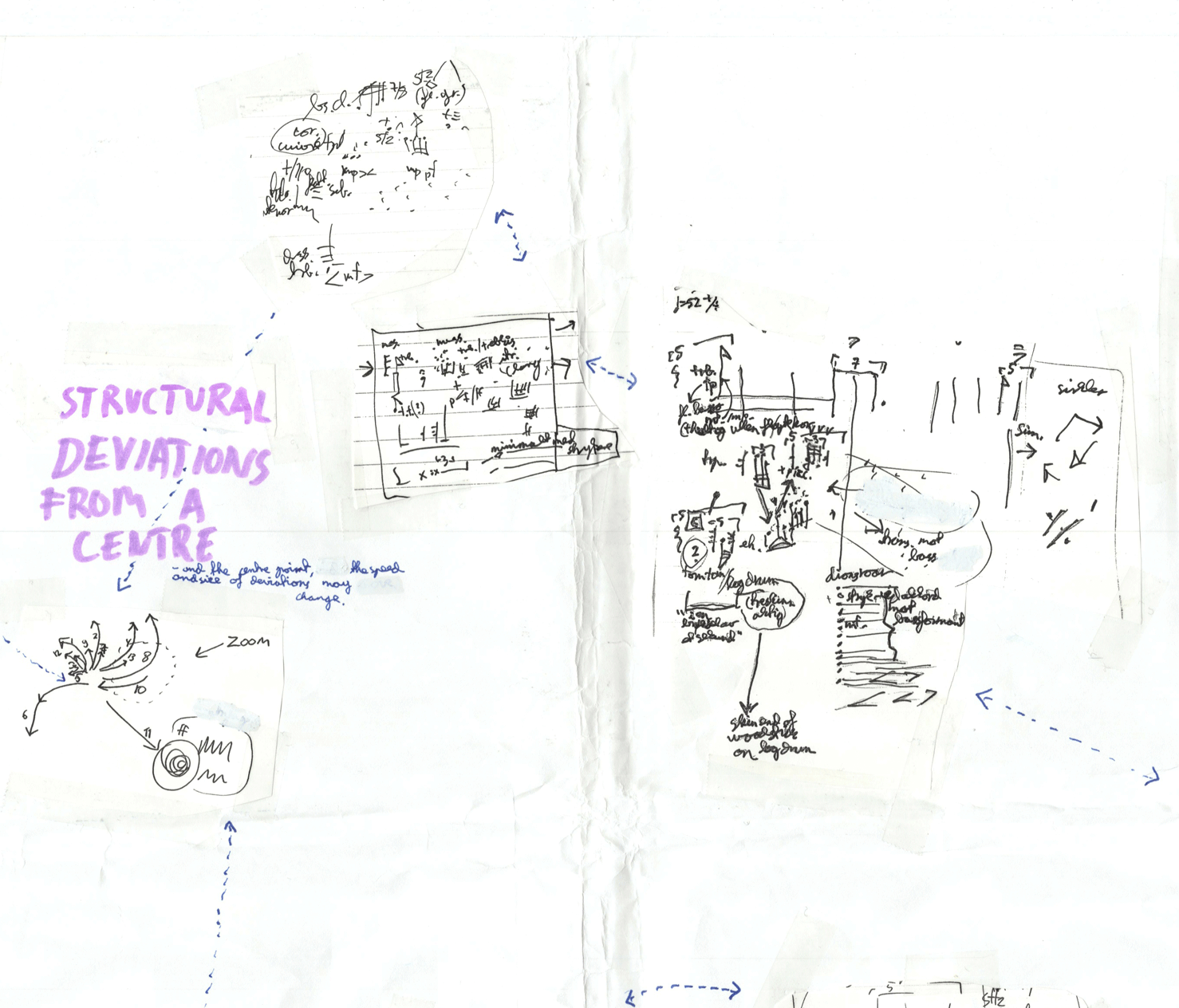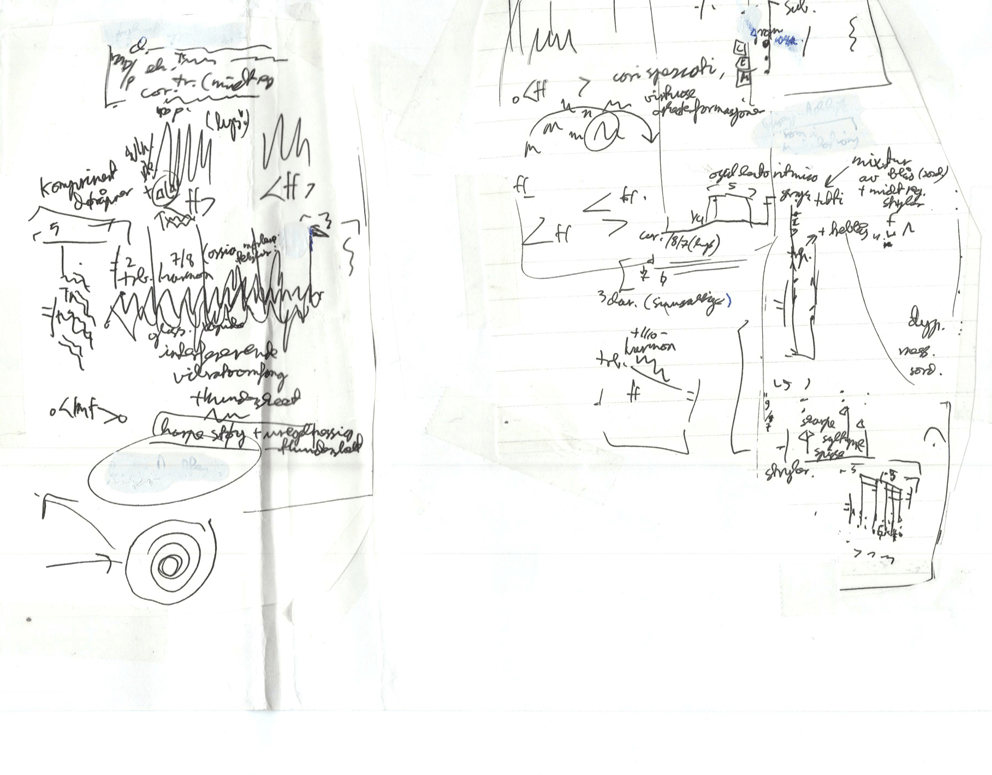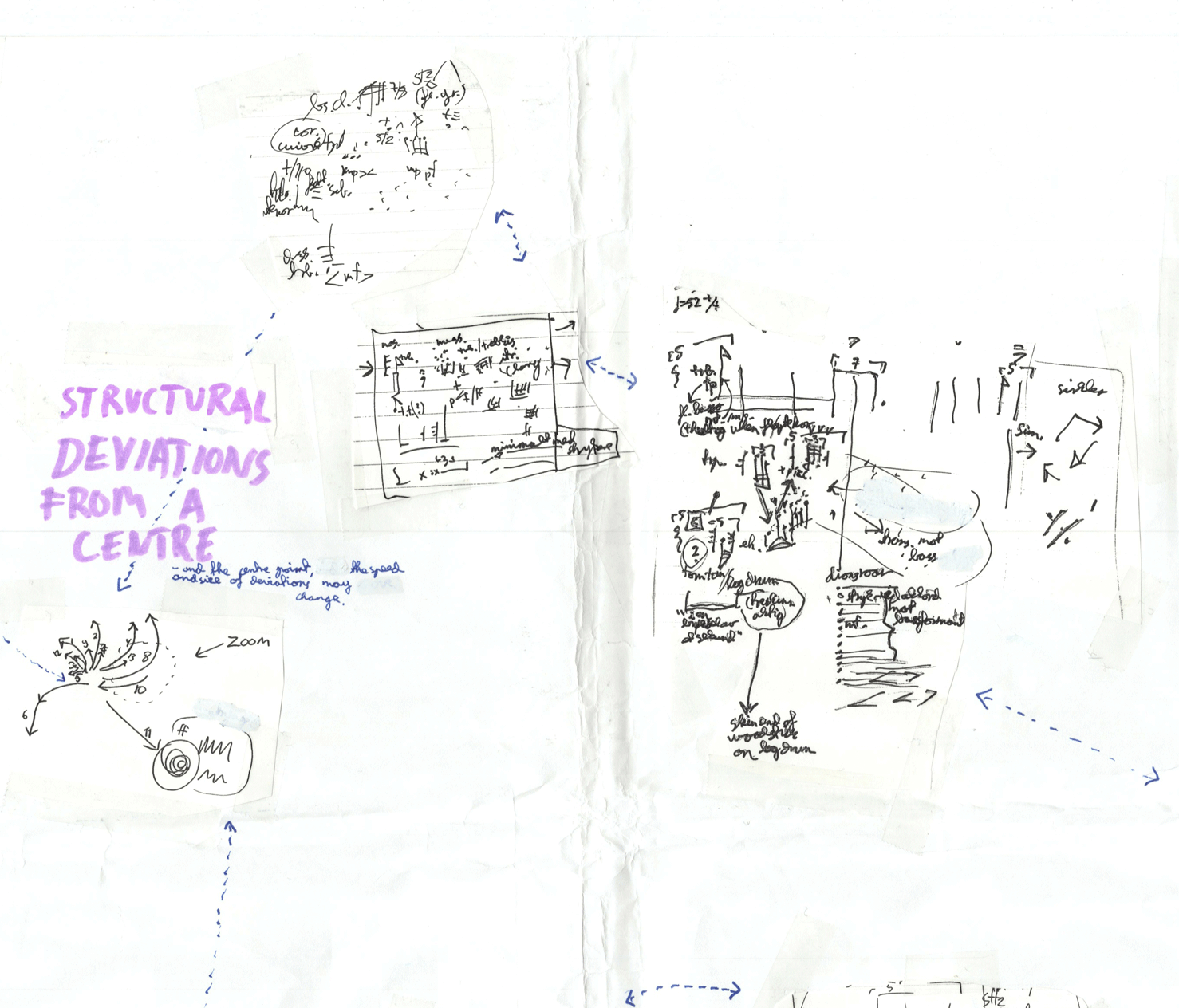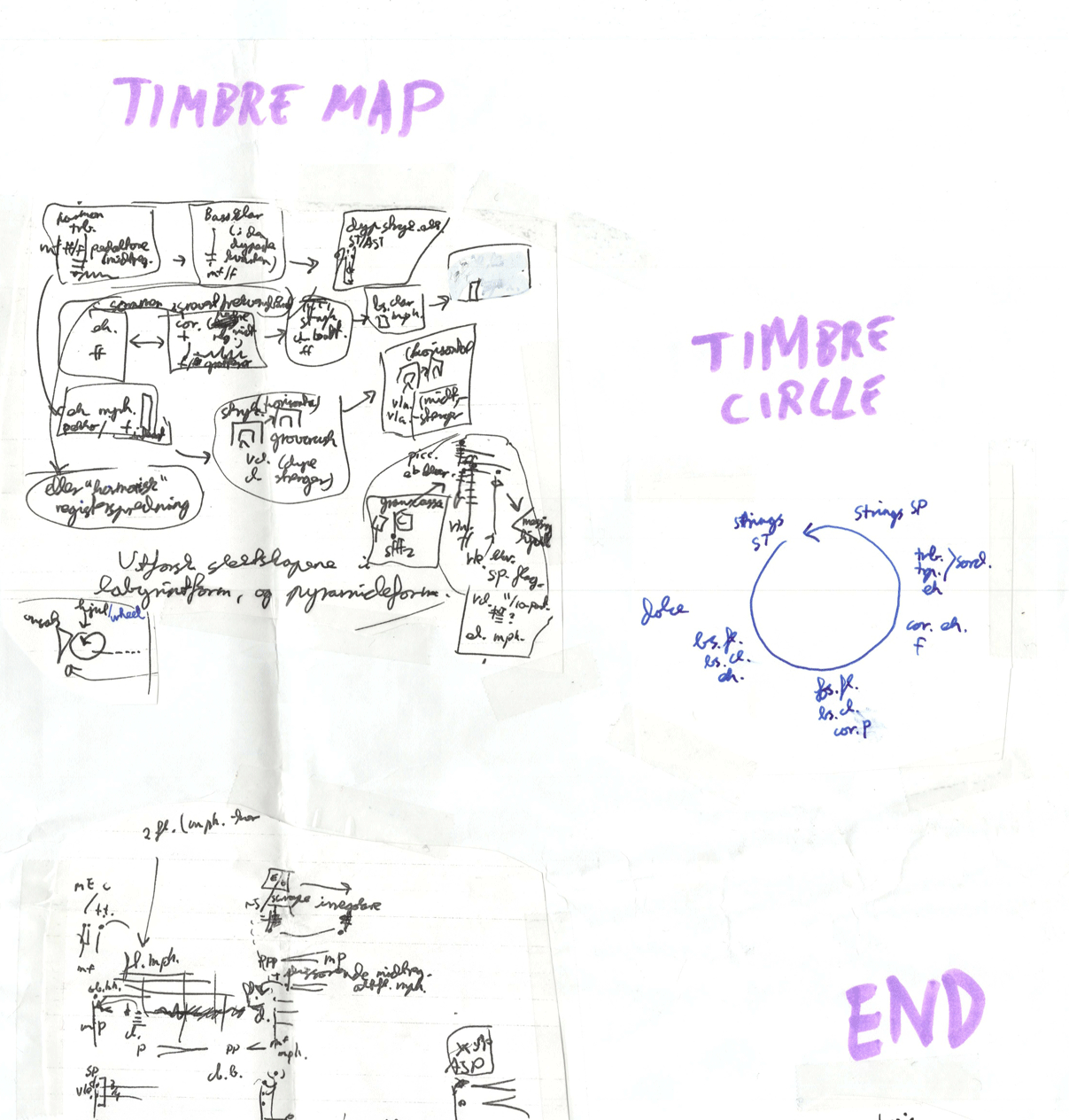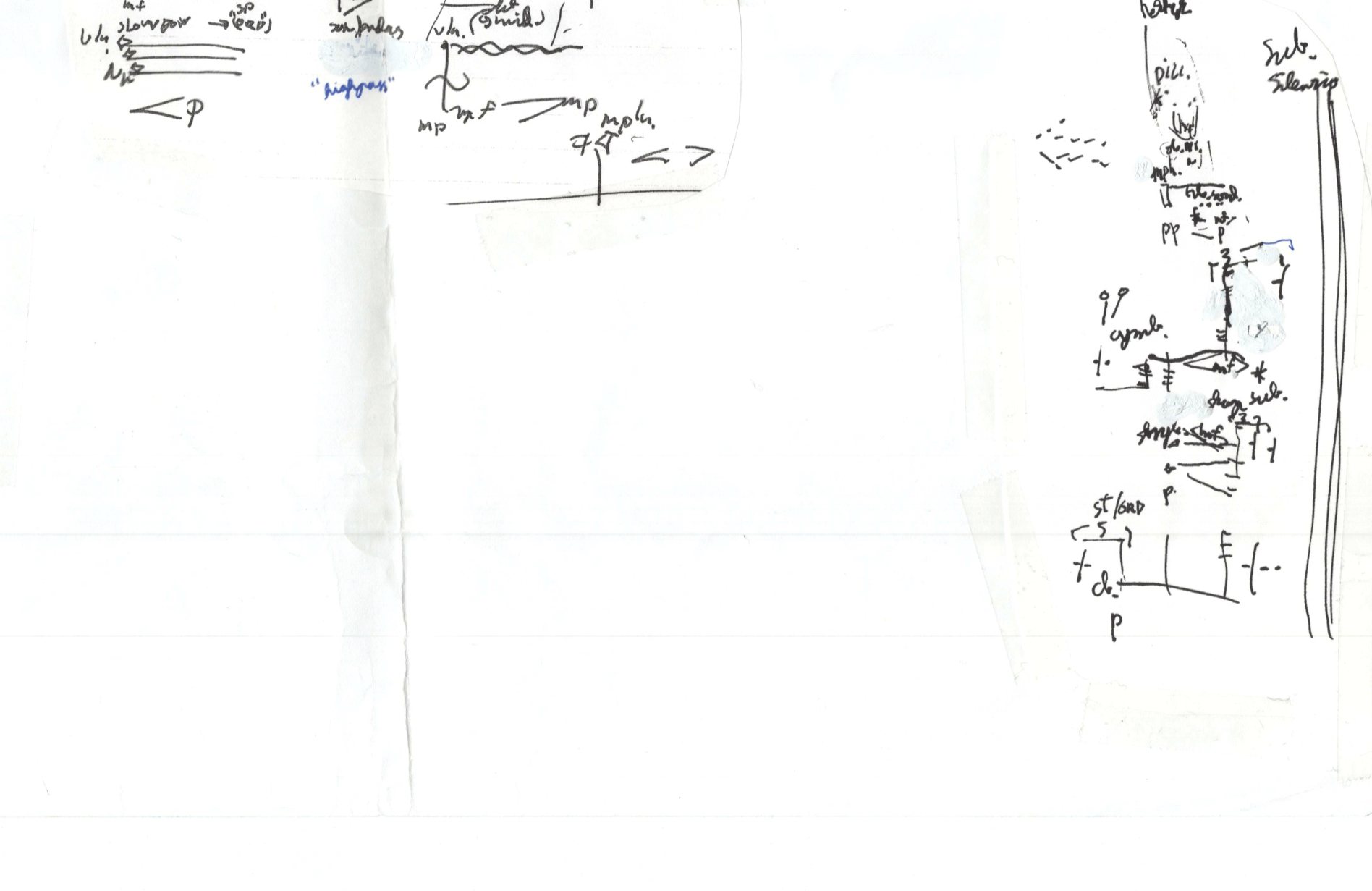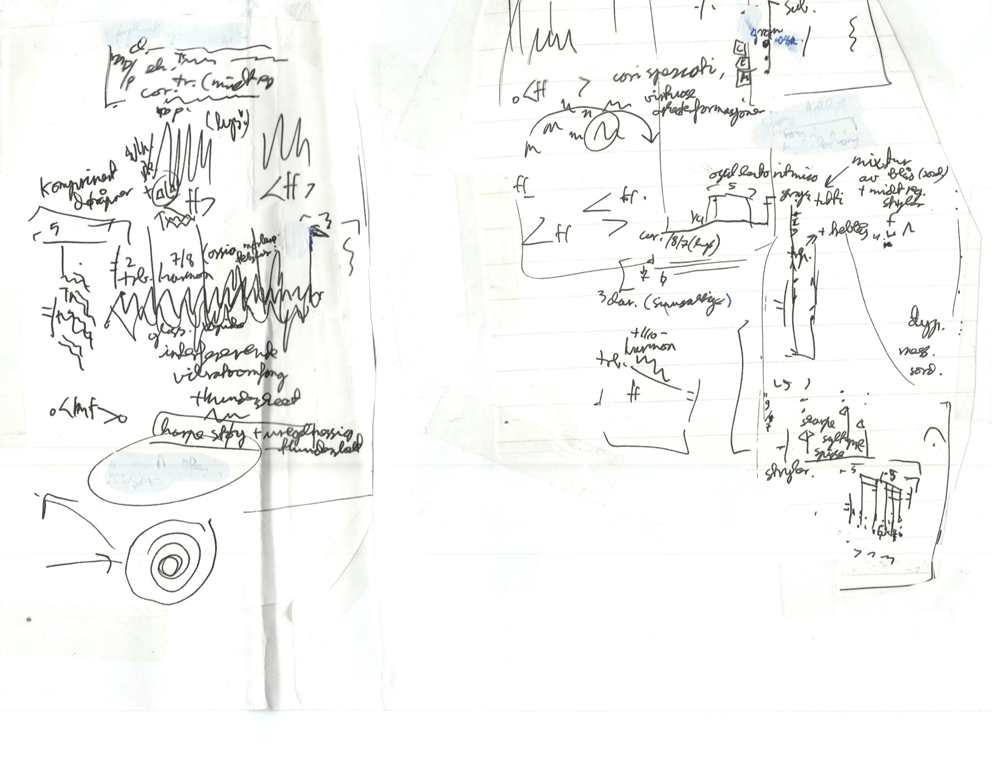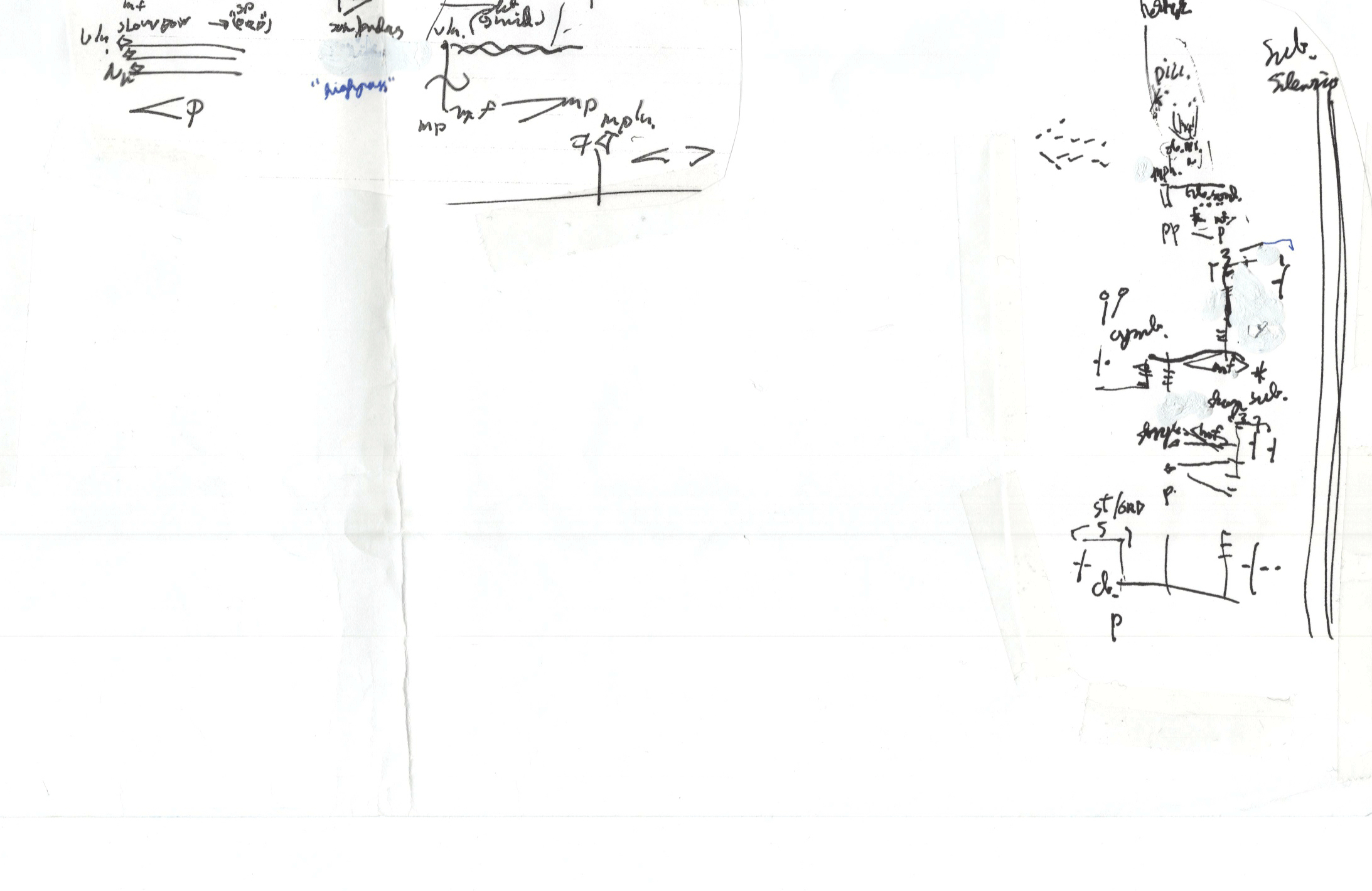Landscape with figures II
Tutti fragment
In the initial project description,[1] I described sketches behind many of my works, especially when a large ensemble is involved. This is a sketch for a fragment of the work Circles (2006).
Circles extract.
Palettes of possible sounds are sketched out, while chronological sketches move through these terrains. Computer assisted methods were used for some detail textures, while outlines and timbres involved had usually been fullyplanned in advance. I had a large amount of these drawings, cutting and pasting them into a chronology. Some times they were copied, cut into tiny pieces, spread, pasted, turned upside down, to extend a musical situation over a longer period of time.
Initial sketches for the work to be Landscape with figures II were sketched out in similar ways.
AC Tutti fragment 1.
I wrote it out in detail fairly quickly without any other system than intuitive preferences of melodic shapes and intervals, and knowlegde about available sounds on the instruments.
The initial freely composed fragment can serve as a musical fingerprint, to go through machines of destruction and erosion.
"Words and rocks contain a language that follows a syntax of splits and ruptures. Look at any word long enough and you will see it open up into a series of faults, into a terrain of particles each containing its own void. This discomforting language of fragmentation offers no easy gestalt solution; the certainties of didactic discourse are hurled into the erosion of the poetic principle. Poetry being forever lost must submit to its own vacuity; it is somehow a product of exhaustion rather than creation. Poetry is always a dying language but never a dead language."[2]
The question is, can we hear which fragments are intuitively composed, and which are manipulated by the computer. It is quite possible we can. I will regard the Open Music distortions of material as digital methods approaching my old ”analog” methods of physically copying, cutting up and pasting pieces of paper, and some times blindfolded picking pieces of paper.
Through James Saunder's composition process for #[unassigned], he made folders of instrumental modules to be placed into time structures.[3] I could well recognize this approach from my past works. I used similar folders of sketches composing the piece Grains (2003).[4] The 'modules' were on earlier stages, specifying instrumentation and textures, but not exact notes and durations, finally placed into macro rhythms and notated in precise linear score. Elements of chance during the composition process can still have an influence on perception of time in the piece. More or less random selections from a folder of ideas could create a kaleidoscopic stasis, rather than the longterm musical developments I have tried to avoid for a long time.
"Phrases have, until recently, pervaded all Western music, even multiply-directed and moment forms: phrases are the final remnant of linearity. But some new works show that phrase structure is not a necessary component of music. The result is a single present stretched out into an enormous duration, a potentially infinite "now" that nonetheless feels like an instant. In music without phrases, without temporal articulation, without total consistency, whatever structure is in the music exists between simultaneous layers of sound, not between successive gestures. Thus, I call the time sense involved by such music "vertical"."[5]
This vertical time sense can form a parallel to vertical 'polymorphic' textures versus the linearity of 'polyphony'. Active gestures or melodic lines can at times be neutralized in a kaleidoscopic situation, potentials of linearity can be interrupted through short durations and placement into arbitrary contexts, and limitations posed by their existence within bubbles. A tam-tam strike cutting the ensemble off will nevertheless have a function, Helmut Lachenmann could call it 'Klang-kadenz'.[6]
The composed fragment go through similar methods as the Ravel percussion fragments, with additional steps to handle ranges of voices and instruments. Some of the functions have been shared in the public Ruben-OM library, some are more specific to my musical preferences.
- The input music has 22 parts.[7] These are given individual MIDI channel numbers, to keep them separate.
- The music is 'granulated',[8] fragments of variable lengths are extracted and superposed. The number of excerpts decide the density of the output fragment.
- Parts are already identified by MIDI channels. Through channel-hocket-multiseq, a large number of fragments are joined back into just 22 parts.
- The music goes through a set of manipulations through curve trajectories; a time pointer, scaling towards inversion, pitch shifting, time scaling, approximation to 1/8-tones. With smooth random curve trajectories, variations will be endless, not just confined to the four forms of Modus Quaternion.
- Filters remove the last of 3 notes, if 2 intervals form a triad included in the "forbidden" list. Many of them are chords with strong tonal associations, or melodic patterns I found less satisfactory. The material is filtered several times by atonal-multiseq, which removes certain interval combinations, particularly those with strong tonal interval tensions. A reservoir of "forbidden" triads were expanded by trial and error. Programming is used to investigate principles in my mind while composing. Asbjørn Schaatun has described the computer as a ”psychoanalyst”.[9]
- The individual parts need to be limited to the available notes on the instrument. These lists of midicents are static, except for the harp, where new modes from particular pedal positions, connected with the quartertone scordatura, are found each time.
- Every part is tested for instrumental range: Let the note pass only if it's an 1/8-tone or less away from a possible note on the instrument.
This does not guarantee a playable results. Many fragments were completely unplayable, which led to creative translations and adaptations to the particular instruments. Composing can happen building structures from nothing, or filtering meaning out from a chaos. This could be compared to the distinction between additive and substractive synthesis of sound.[10] Some times the computer distorted the materials, some times it made surprisingly clear ideas.
What I try to do in the final phases is making sense of this 'fractured world', interprete materials to available sounds on the instrument. I made more than 100 distorted tutti fragments and selected 7 versions with potential. BY Tutti Fragment 4 was one of them.
For comparison, this is the raw material for measure 6 of BY Tutti Fragment 4:
Certain notes or figures were often removed manually before the score was exported, clarifying relations of sound and silence, or economy of movement, finding focus from periods of "computer babbling". We can hear how the initial and unplayable raw materials sounded through a MIDI performance.
BY Tutti Fragment 4 MIDI raw material.
This is how the same measure was freely and idiomatically interpreted.
Final version of BY Tutti Fragment 4.
Many phrases and rhythms can be recognized. The textures have been thinned out, difficult string figures are replaced by bouncing and wiggling techniques. Vivid pitch figures can be brought to density of a sound phenomena rather than an exact reproduction of the raw materials.
The microtonal organ is tuned in the ’random pelog 39’ tuning.[11] Sounding pitch will be very different from the notated pitch, as well as the raw materials. I did a lot of changes while testing the organ. When adapting the organ part in all fragments of this work, the first question was which tuning system and organ registers should be used for the fragment. These initial choices had huge consequences, turning raw materials into impulses to explore sonorities of microtonal tunings.
Tunings collide with the maximum 1/8-tone approximations of ensemble. I did not find this a problem in the performance, collisions of tunings are welcome within this sound aesthetics. There could be several reasons why I did not find it problematic.
- Microtones will not get purely equal tempered within a ensemble (except the celesta and tuned percussion). Microtonal fingerings on woodwinds are rather irregular, and not exact microtonal equal tempered scales.
- Multiphonics on woodwinds are difficult to define, pitch content can vary between instruments. These are irregular timbral phenomena.
- Unpitched percussion instruments or noise based performing techniques on other instruments bring sound into a domain where centered pitch doesn't have the primary focus. In one of his tables, Pierre Schaeffer suggests 7 degrees: 'son pur', 'son tonique', 'groupe tonique', 'cannelé', 'groupe nodal', 'son nodal', 'bruit blanc ou coloré'.[12] Unpitched percussion instruments come closer to the 'nodal' categories, while woodwind multiphonics can be seen as 'groupe tonique' of identifiable microtonal pitches.
- A collision of intonation will create beating effects. I have deliberately been looking for beatings through parallel concert pitches on the microtonal organ, or through dense tunings used for the sound installation fragments.
Kjell Tore Innervik's quartertone glockenspiel[13] operates in equal tempered quartertones. Intonation differences was not a problem, but contributed to a multitude of sonorities.
Ensemble fragment 5 was intuitively sketched and composed, but not used for further processing.
AR Tutti fragment 5.
[2] Smithson, 1979 (utg. 1996), The collected writings, A sedimentation of the mind, 107. I quoted this in my master thesis 2006.
[8] The word can be tranferred from extracting, superposing and reordering segments of a sound on a micro level, known as ’granular synthesis’, to applying similar methods to fragments of a musical composition.
[9] Asbjørn Schaatun, 1989, The computer as a psychoanalyst, thoughts on computer-aided composition.
[10] In additive synthesis, timbres are built from sine waves. In substractive synthesis, timbres are found through filtering of noise.
[11] Available in the 3 Manual Microtonal Organ: http://rubensverregjertsen.com/researchsoftware.html
[Link updated 2018.] Interval reservoir for random pelog tunings is shown in the organ documentation.
